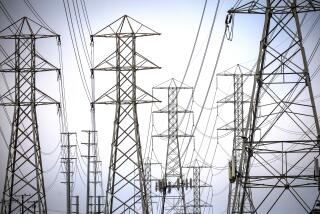Energy Crisis Still Generating Problems
California suffered the energy equivalent of a nervous breakdown in 2001, a year marked by six days of blackouts, enormous energy costs, the largest electricity rate increase in state history, a bankruptcy filing of the stateâs largest electricity utility and the financial rescue of No. 2, Southern California Edison Co.
But it could have been much worse.
The state avoided the much-predicted plague of blackouts this summer because of mild weather, heavy conservation and a crash power-plant-building program.
California cruised into winter with lower costs for natural gas and wholesale electricity, along with relatively cushy power supplies.
Although the California Energy Commission expects that the state will have sufficient electricity supplies in 2002, the coming year holds the promise of continuing high electricity rates for the 10 million customers of Pacific Gas & Electric Co., Edison Internationalâs Southern California Edison and San Diego Gas & Electric Co. And state officials have not figured out how to repay the $6 billion that was borrowed from the stateâs general fund so the California Department of Water Resources could buy electricity for the three investor-owned utilities as they got battered in a volatile, deregulated market.
As state energy officials put it in a recent electricity forecast, âCaliforniaâs efforts to substitute competition for cost-based regulation ... have fallen substantially short of expectations.â
California is left with an odd hybrid electricity system combining elements of deregulation of power generation and wholesale markets with even stronger government involvement, including renewed interest in keeping regulation of retail electricity markets for the foreseeable future. The results probably will be expensive.
âWe expect California will remain an island of high electricity prices for the next few years,â said Michael Zenker, director of the California office of Cambridge Energy Research Associates. Neighboring states, in contrast, are seeing rates decline now that wholesale markets have stabilized, he said.
California deregulated its electricity industry in 1998 with the lure of lower rates for consumers and business. Customer rates were frozen and larger business customers saw costs decrease for a while.
Electricity costs began to skyrocket in 2000; state officials and regulators said power plant owners and electricity traders were manipulating the market, but generators said prices were rising because high demand was bumping up against tight supplies.
Because PG&E; and Edison could not pass along these higher costs to customers whose rates were frozen, enormous debts piled up and, in January, generators refused to sell the utilities electricity anymore. Gov. Gray Davis declared a state of emergency and the California Department of Water Resources was forced to assume the role of the stateâs primary power buyer.
Customer rates were increased twice to help pay for power costs, but Davis and the California Public Utilities Commission remain at an impasse about how to float bonds to repay some of the stateâs power debts.
To tame power costs, the DWR signed more than $43 billion in long-term power contracts that are now condemned by critics as too expensive. The agency is seeking to renegotiate some of those contracts. Meanwhile, businesses and consumers remain locked into high retail electricity rates.
A state power authority was formed to build power plants and transmission lines, among other things, but has had little to do so far.
Deregulation was further dismantled when the PUC suspended a program that allowed customers to choose an electricity provider other than the traditional utility.
PG&E; filed for Chapter 11 bankruptcy protection in April while Edison pursued a rescue through Davis and the Legislature.
After lawmakers failed to agree on an Edison rescue bill, the PUC devised a plan to repay Edisonâs $6.35 billion in electricity debts by keeping customer rates high for at least two years and requiring shareholders to forgo dividends.
In the end, consumers have suffered the most from the stateâs disastrous foray into electricity competition, activists say.
A consumer group is seeking to block the Edison rescue in court and another is considering a ballot initiative for November to undo the Edison rescue and to return the stateâs electricity business to some form of regulation.
More to Read
Inside the business of entertainment
The Wide Shot brings you news, analysis and insights on everything from streaming wars to production â and what it all means for the future.
You may occasionally receive promotional content from the Los Angeles Times.










